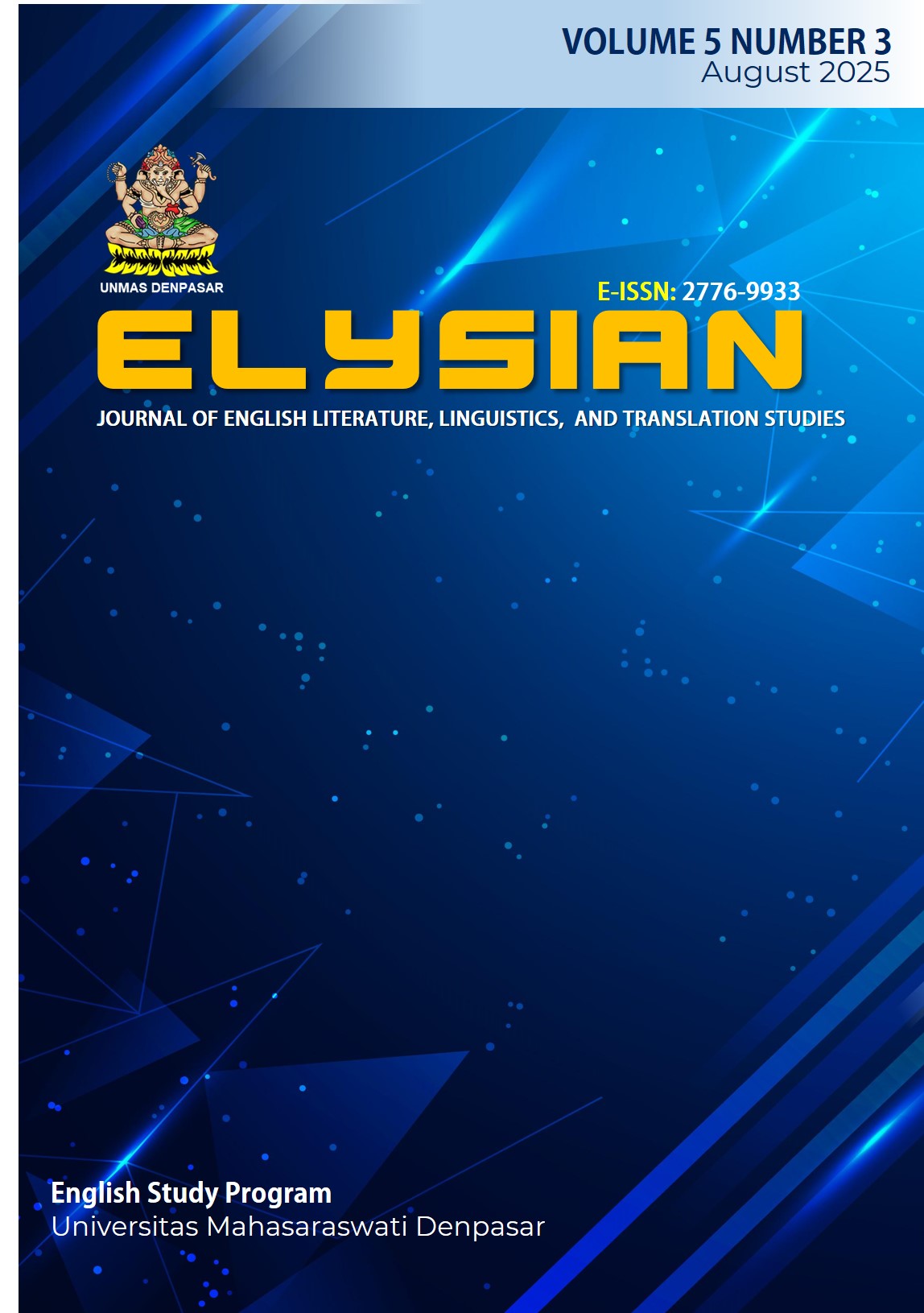An Analysis of Expressive Functional Language in the Movie A Man Called Otto
DOI:
https://doi.org/10.36733/elysian.v5i3.12196Keywords:
expressive function, emotional language, film dialogue, HallidayAbstract
With an emphasis on how the characters' speech reflects their emotional states and the dynamics of their relationships, the current research attempts to analyze the usage of expressive language functions in the 2022 movie A Man Called Otto. Using information from the speech of the main character, Otto Anderson, as well as the speech of the supporting characters who affect Otto's emotional reactions, the current research uses a qualitative descriptive approach. Data were collected through repeated observation of the film, involving transcription and contextual note-taking that captured setting, interlocutors, and emotional tone. Content analysis was used to categorize the data according to Halliday’s (1973) theory of language functions, with particular emphasis on the expressive or personal function. The findings reveal that Otto’s dialogue predominantly features emotive, affective, and assertive expressions, while supporting characters provide empathetic and encouraging utterances that influence the emotional progression of the narrative. The study contributes to linguistic and cinematic discourse analysis by offering a detailed account of how expressive functions are structured both syntactically and contextually within film dialogue.
References
Agung, P. (2023). Analisis naratif pesan moral pada film A Man Called Otto (Bachelor's thesis, Fakultas Dakwah dan Ilmu Komunikasi, Universitas Islam Negeri Syarif Hidayatullah Jakarta).
Anggraeni, R. (2024). Expressive and interactional functions in the film Wonder (2017) (Bachelor's thesis, Universitas Negeri Jakarta).
Aprilia, D. (2021). Expressive language function in Little Women (2019): A pragmatic approach (Undergraduate thesis, Universitas Negeri Yogyakarta).
Arslan, A., & Turk, M. (2024). Wikipedia as an academic service-learning tool in science and technology: Higher education case from Siberia. Journal of Community Genetics, 15(2), 147–161.
Az-Zahra, N. L. (2022). The use of expressive and directive language functions in Joker (2019) (Undergraduate thesis, Universitas Islam Negeri Raden Intan Lampung).
Baroudi, M. E. (2021). A stylistic analysis of honest deception: The case of Seinfeld TV series sitcom. arXiv preprint, arXiv:2104.08599.
Feng, D., & O’Halloran, K. L. (2013). The multimodal representation of emotion in film: Integrating cognitive and semiotic approaches. Semiotica, 2013(197), 79–100.
Foolen, A. (2011). The expressive function of language: Towards a cognitive semantic approach. In The language of emotions (pp. 15–32). John Benjamins Publishing Company.
Hamdhani, R. (2024). The linguistic relationship between speech styles and functions (Doctoral dissertation, Universitas Gadjah Mada).
Harif, A. I. A. (2024). Representasi depresi dalam film "A Man Called Otto" (Doctoral dissertation, Universitas Mercu Buana Jakarta).
Halliday, M. A. K. (1975). Learning how to mean. In Foundations of language development (pp. 239–265). Academic Press.
Halliday, M. A. K., & Matthiessen, C. M. I. M. (2004). An introduction to functional grammar (3rd ed.). Edward Arnold.
Halliday, M. A. K., & Matthiessen, C. M. (1994). An introduction to functional grammar. Hodder Education.
Hasan, R. (2009). Wanted: A theory for integrated sociolinguistics. In The collected works of Ruqaiya Hasan (Vol. 2, pp. 5–40).
Irianti, D. (2023). An analysis of expressive speech act used by the characters in A Man Called Otto movie (Undergraduate thesis). Faculty of Letters and Cultures, Gunadarma University.
Kim, E., & Klinger, R. (2019). An analysis of emotion communication channels in fan fiction: Towards emotional storytelling. arXiv preprint, arXiv:1906.02402.
Leipold, S., Feindt, P. H., Winkel, G., & Keller, R. (2019). Discourse analysis of environmental policy revisited: Traditions, trends, perspectives. Journal of Environmental Policy & Planning, 21(5), 445–463.
Murtagh, F., & Ganz, A. (2015). Pattern recognition in narrative: Tracking emotional expression in context. Journal of Data Mining & Digital Humanities, 2015.
Nismoro, R., Mulyani, H. S., & Puspitasari, L. (2024). Analisis perilaku karakter Marisol dalam film A Man Called Otto sebagai representasi kepedulian sosial. Imajinasi: Jurnal Ilmu Pengetahuan, Seni, dan Teknologi, 1(3), 26–46.
Pramudita, T., Triyogo, A., & Oktaviani, A. (2025). An analysis of directive speech act in the A Man Called Otto movie. TUTURAN: Jurnal Ilmu Komunikasi, Sosial dan Humaniora, 3(2), 20–37.
Ramadhani, N. (2023). A functional analysis of expressive language in the male lead of Enchanted (2007) (Bachelor's thesis, Universitas Islam Malang).
Sari, D. P. (2021). Character development through expressive utterances in redemption-themed films (Bachelor's thesis, Universitas Pendidikan Indonesia).
Schmied, J. (2021). Popular digital knowledge dissemination platforms: Evaluating the pragmatic professional credibility from Wikipedia to Academia.edu and ResearchGate. Journal of Pragmatics, 180, 187–202.
Tseng, C. I. (2013). Analysing characters' interactions in filmic text: A functional semiotic approach. Social Semiotics, 23(5), 587–605.
Uzira, C. F. P., Nasir, C., & Erdiana, N. (2023). An analysis of moral values in the movie A Man Called Otto (2022). Research in English and Education Journal, 8(4), 209–217.








